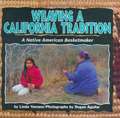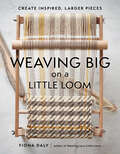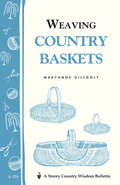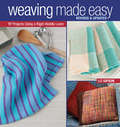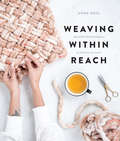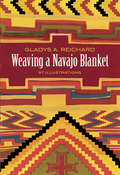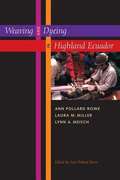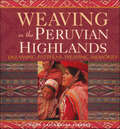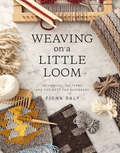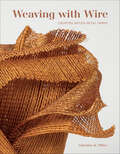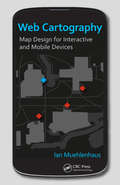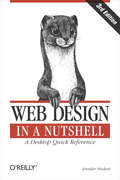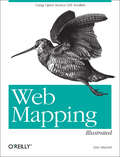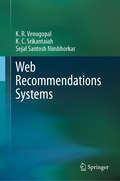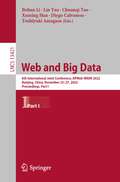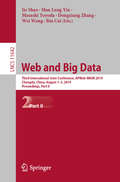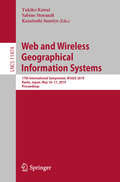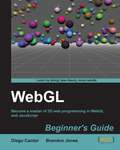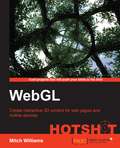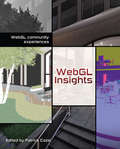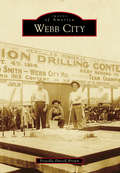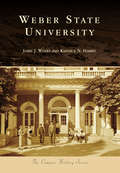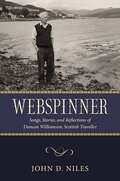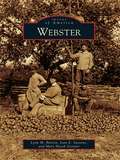- Table View
- List View
Weaving A California Tradition: A Native American Basketmaker
by Linda YamaneCarla is 11 years old and lives in Dunlap, California. This richly detailed photographic essay accompanies her as she goes through the process of making a basket, from gathering the plants, to weaving, to attending a gathering of California basketweavers, where she enters her work in a show.
Weaving Big on a Little Loom: Create Inspired Larger Pieces
by Fiona DalyFor intermediate and advanced crafters, these eight illustrated loom weaving projects help you create sustainable, attractive, and useful textile pieces for your home and wardrobe—or to give as gifts. This step-by-step guide to weaving large projects on a little loom is packed with over 200 color photographs.Use your frame loom to create eight large, impactful weaving projects, including an oversized scarf, a snood, a shoulder bag, a mesh shopping bag, a bathroom mat, a table runner, and two types of cushions. With straightforward instructions, weave patterns, and vivid color photography, this helpful how-to guide leads you through each step of these inspired projects.First, choose your materials, focusing on finding the best, most sustainable textiles and yarns for your project. Next, learn about a special type of frame loom with a detachable top and bottom bar that will enable you to create pieces up to six and a half feet in length. Learn how to create 8 different weave structures, then, try your hand at each of the eight creative large-scale loom projects that are sure to impress family and friends. Once you're finished, you can proudly wear, carry, or display your contemporary weave work anywhere. You can also learn how to make your own frame loom for large projects using a simple guide.
Weaving Country Baskets: Storey Country Wisdom Bulletin A-159 (Storey Country Wisdom Bulletin Ser.)
by Maryanne GilloolySince 1973, Storey's Country Wisdom Bulletins have offered practical, hands-on instructions designed to help readers master dozens of country living skills quickly and easily. There are now more than 170 titles in this series, and their remarkable popularity reflects the common desire of country and city dwellers alike to cultivate personal independence in everyday life.
Weaving Made Easy Revised and Updated: 17 Projects Using a Rigid-Heddle Loom
by Liz GipsonCreate beautiful cloth with just a simple loom.This easy and accessible guide to weaving uses the simple rigid-heddle loom to create fabrics that are a perfect blend of fun and functionality. The rigid-heddle loom is small, portable, and affordable, making it the perfect starting point for anyone wanting to learn how to weave. 17 quick and easy weaving projects show how to make fabrics that are soft and drapey, sturdy and practical, or just plain fun and funky.Projects include woven scarves and belts, pillows, napkins, and hand-woven rugs. Complete, updated instructions for warping a loom, clear step-by-step photos and abundant tips, tricks, and techniques for color, design, and embellishment are included. Weaving Made Easy is the ultimate idea book for the beginning weaver.
Weaving Made Easy: 17 Projects Using a Simple Loom
by Liz GipsonWeaving Made Easy is the beginning weavers' ultimate guide to making fun, simple, and functional weaving projects from start to finish. It features seventeen simple projects made on the rigid heddle loom, a small, portable, and affordable weaving loom.Weaving Made Easy includes:A step-by-step guide on getting started weaving; weaving vocab 101, tools and materials explained, the basics of warp and weft, and how to start weavingClear instructions for how to make various practical fabrics, from drapy to sturdy scarves and bags to belts, placemats, rugs, and more.Weaving Made Easy includes an abundance of tips and techniques for color, design, construction, and embellishment in weaving. With clear, concise step-by-step photographs and instructions, this is the ideal book for beginning weavers.
Weaving Within Reach: Beautiful Woven Projects by Hand or by Loom
by Anne Weil<p>Modern weaving projects like you've never seen—within easy reach of anyone. Weaving is a satisfying hobby for making home or clothing accessories that look plucked from your favorite stores. Here are Pinterest-worthy projects for creating earrings, clutches, pillows, wall hangings, and more, all organized by skill level. From complete beginner to intermediate, Weaving Within Reach allows you to craft at your comfort level, even if you don’t yet know the difference between the warp and the weft. <p>Lacking a loom? Most of the materials can be woven on found objects—such as an embroidery hoop or cardboard box—or achieved with a simple over-under pattern using no loom at all. As you progress, there are plenty of exciting designs for a frame loom to keep you inspired. With a detailed introduction, stunning lifestyle and step-by-step photographs, and a helpful resource section, Weaving Within Reach unravels the possibilities of the beautiful things you can make with your hands.</p>
Weaving a Navajo Blanket
by Gladys A. ReichardThe author spent four summers (1930–33) living and working among the Navajo, during which time she learned the principles of weaving. In this book she takes readers through the same process, introducing the careful details, the personalities she encountered, and the materials and methods of weaving in the Navajo style.The spinning of the yarn, the dyes, the equipment, the weaving processes, the designs and colors, even the tensions and textures of the final product are all part of weaving a Navajo blanket. The author guides readers through each step, from choosing the wool through carding and spinning warp and weft yarns, building and setting up a loom, creating a design, and carrying out the actual weaving. Although the emphasis is on typical blanket weaving, the author also covers the related arts of saddleblanket weaving, warp weaving, scalloped edge weaving, double-faced weaving, and sandpainting tapestries. She also comments on history, patterns, symbolism, the effect of the market, and other matters that affect the Navajo weaving style. In five appendixes she reviews the implements and materials of weaving, Navajo materials for natural dyes, weaving terms, and simple lessons in learning to weave a Navajo blanket. Nearly 100 photographs and line drawings illustrate the processes and finished work.Crafters, whether they want to start from scratch or gradually add Navajo elements to their other weaving skills, will learn from this book the authentic steps of Navajo weaving. Collectors, ethnologists, and others will learn more about materials, techniques, and related matters that will help them in judging, appraising, and enjoying the processes that go into weaving a Navajo blanket.
Weaving and Dyeing in Highland Ecuador
by Ann Pollard Rowe Laura M. MillerAlthough less well known than its much-admired counterparts in Peru and Bolivia, highland Ecuadorian weaving is an Andean tradition that has relationships with these more southern areas. A world away from the industrialized textile manufacturing of Euro-American society, these handmade pieces reflect the history and artistry of an ancient culture.
Weaving in the Peruvian Highlands: Dreaming Patterns, Weaving Memories
by Nilda Callañaupa AlvarezA richly illustrated, bilingual book, this guide visits 20 villages in the Chiapas Highlands to showcase their stunning handwoven cloth while also providing an insider&’s look into their history, folklore, festivals, traditions, and daily lives. Ritual transvestites, Virgin statues draped with native blouses, tunics designed to look like howler monkey fur, and elaborately floral shawls and ponchos—these are just a few of the unforgettable images captured in the book. Also included are a pull-out map of the Chiapas Highlands and dates of special festivals and local markets.
Weaving on a Little Loom: Techniques, Patterns, and Projects for Beginners
by Fiona DalyWeaving on a Little Loom teaches readers everything they need to know to start small-frame loom weaving, an easy and inexpensive craft that can be done at home. From setting up the loom to finishing a project, this book covers both basic and more advanced techniques, with an introduction to creating patterns such as basket and bird's eye weaves, rib, twill, and herringbone. With clear instruction and beautiful illustrative photographs, step-by-step tutorials guide you through designing and creating five contemporary woven projects—including table placemats, wall hangings, and a tote bag—all made with natural, environmentally friendly materials.
Weaving with Wire: Creating Woven Metal Fabric
by Christine K. MillerLearn a new weaving technique using a wire warp and fiber weft on a multiharness loomUse the strong, flexible, malleable fabric to craft jewelry, baskets, sculpture, wall art, and moreIncludes woven-wire creations from author and other weavers with information to re-create them or use as inspiration
Web Cartography: Map Design for Interactive and Mobile Devices
by Ian MuehlenhausWeb mapping technologies continue to evolve at an incredible pace. Technology is but one facet of web map creation, however. Map design, aesthetics, and user-interactivity are equally important for effective map communication. From interactivity to graphical user interface design, from symbolization choices to animation, and from layout to typeface
Web Design in a Nutshell: A Desktop Quick Reference
by Jennifer Niederst RobbinsAre you still designing web sites like it's 1999? If so, you're in for a surprise. Since the last edition of this book appeared five years ago, there has been a major climate change with regard to web standards. Designers are no longer using (X)HTML as a design tool, but as a means of defining the meaning and structure of content. Cascading Style Sheets are no longer just something interesting to tinker with, but rather a reliable method for handling all matters of presentation, from fonts and colors to the layout of the entire page. In fact, following the standards is now a mandate of professional web design.Our popular reference, Web Design in a Nutshell, is one of the first books to capture this new web landscape with an edition that's been completely rewritten and expanded to reflect the state of the art. In addition to being an authoritative reference for (X)HTML and Cascading Style Sheets, this book also provides an overview of the unique requirements of designing for the Web and gets to the nitty-gritty of JavaScript and DOM Scripting, web graphics optimization, and multimedia production. It is an indispensable tool for web designers and developers of all levels.The third edition covers these contemporary web design topics:Structural layer: HTML 4.01 and XHTML 1.0 (9 chapters), including an alphabetical reference of all elements, attributes and character entitiesPresentation layer: Ten all-new chapters on Cascading Style Sheets, Level 2.1, including an alphabetical reference of all properties and values.Behavior layer: JavaScript and scripting with the Document Object Model (DOM)Web environment: New web standards, browsers, display devices, accessibility, and internationalizationWeb graphics optimization: Producing lean and mean GIF, JPEG, PNG, and animated GIFsMultimedia: Web audio, video, Flash, and PDFOrganized so that readers can find answers quickly, Web Design in a Nutshell, Third Edition helps experienced designers come up to speed quickly on standards-based web design, and serves as a quick reference for those already familiar with the new standards and technology.There are many books for web designers, but none that address such a wide variety of topics. Find out why nearly half a million buyers have made this the most popular web design book available.
Web Mapping Illustrated: Using Open Source GIS Toolkits
by Tyler MitchellWith the help of the Internet and accompanying tools, creating and publishing online maps has become easier and rich with options. A city guide web site can use maps to show the location of restaurants, museums, and art venues. A business can post a map for reaching its offices. The state government can present a map showing average income by area.Developers who want to publish maps on the web often discover that commercial tools cost too much and hunting down the free tools scattered across Internet can use up too much of your time and resources. Web Mapping Illustrated shows you how to create maps, even interactive maps, with free tools, including MapServer, OpenEV, GDAL/OGR, and PostGIS. It also explains how to find, collect, understand, use, and share mapping data, both over the traditional Web and using OGC-standard services like WFS and WMS.Mapping is a growing field that goes beyond collecting and analyzing GIS data. Web Mapping Illustrated shows how to combine free geographic data, GPS, and data management tools into one resource for your mapping information needs so you don't have to lose your way while searching for it.Remember the fun you had exploring the world with maps? Experience the fun again with Web Mapping Illustrated. This book will take you on a direct route to creating valuable maps.
Web Recommendations Systems
by K. R. Venugopal K. C. Srikantaiah Sejal Santosh NimbhorkarThis book focuses on Web recommender systems, offering an overview of approaches to develop these state-of-the-art systems. It also presents algorithmic approaches in the field of Web recommendations by extracting knowledge from Web logs, Web page content and hyperlinks. Recommender systems have been used in diverse applications, including query log mining, social networking, news recommendations and computational advertising, and with the explosive growth of Web content, Web recommendations have become a critical aspect of all search engines. The book discusses how to measure the effectiveness of recommender systems, illustrating the methods with practical case studies. It strikes a balance between fundamental concepts and state-of-the-art technologies, providing readers with valuable insights into Web recommender systems.
Web and Big Data: 6th International Joint Conference, APWeb-WAIM 2022, Nanjing, China, November 25–27, 2022, Proceedings, Part I (Lecture Notes in Computer Science #13421)
by Diego Calvanese Bohan Li Lin Yue Chuanqi Tao Xuming Han Toshiyuki AmagasaThis three-volume set, LNCS 13421, 13422 and 13423, constitutes the thoroughly refereed proceedings of the 6th International Joint Conference, APWeb-WAIM 2022, held in Nanjing, China, in August 2022.The 75 full papers presented together with 45 short papers, and 5 demonstration papers were carefully reviewed and selected from 297 submissions. The papers are organized around the following topics: Big Data Analytic and Management, Advanced database and web applications, Cloud Computing and Crowdsourcing, Data Mining, Graph Data and Social Networks, Information Extraction and Retrieval, Knowledge Graph, Machine Learning, Query processing and optimization, Recommender Systems, Security, privacy, and trust and Blockchain data management and applications, and Spatial and multi-media data.
Web and Big Data: Third International Joint Conference, APWeb-WAIM 2019, Chengdu, China, August 1–3, 2019, Proceedings, Part II (Lecture Notes in Computer Science #11642)
by Wei Wang Bin Cui Jie Shao Man Lung Yiu Masashi Toyoda Dongxiang ZhangThis two-volume set, LNCS 11641 and 11642, constitutes the thoroughly refereed proceedings of the Third International Joint Conference, APWeb-WAIM 2019, held in Chengdu, China, in August 2019. The 42 full papers presented together with 17 short papers, and 6 demonstration papers were carefully reviewed and selected from 180 submissions. The papers are organized around the following topics: Big Data Analytics; Data and Information Quality; Data Mining and Application; Graph Data and Social Networks; Information Extraction and Retrieval; Knowledge Graph; Machine Learning; Recommender Systems; Storage, Indexing and Physical Database Design; Spatial, Temporal and Multimedia Databases; Text Analysis and Mining; and Demo.
Web and Wireless Geographical Information Systems: 17th International Symposium, W2GIS 2019, Kyoto, Japan, May 16–17, 2019, Proceedings (Lecture Notes in Computer Science #11474)
by Kazutoshi Sumiya Yukiko Kawai Sabine StorandtThis book constitutes the refereed proceedings of the 17th International Symposium on Web and Wireless Geographical Information Systems, W2GIS 2019, held in Kyoto, Japan, in May 2019. The 10 full papers included in the volume together with a keynote paper and 3 work-in-progress papers were carefully reviewed and selected from 37 submissions. The papers discuss advances in theoretical, technical, and practical issues in the field of wireless and Internet technologies suited for the dissemination, usage, and processing of geo-referenced data. They cover topics such as Web technologies and techniques, paths and navigation, Web visualization, and novel applications.
WebGL Beginner's Guide
by Diego Cantor Brandon JonesThis book is a step-by-step tutorial that includes complete source code for all of the examples covered. Every chapter builds on top of the previous one thereby giving the reader an immediate feeling of progression. Each block of code is explained, and 3D web development concepts are diagrammed and covered in detail. This book is written for JavaScript developers who are interested in 3D web development. A basic understanding of the DOM object model and the jQuery library is ideal but not required. No prior WebGL knowledge is expected.
WebGL Hotshot
by Mitch WilliamsEvery chapter starts with a 'mission briefing' section that describes what is to be achieved by the end of the chapter. This is followed with the decisions and steps required to accomplish the mission objective with challenges to take the project further. The scope for the book thus mimics the reallife requirements of a developer and gets you ready to successfully build your own project. If you are a web designer looking to expand your knowledge of 3D graphics concepts and broaden your existing skill set, then this book is for you. Those looking for an introduction to 3D graphics will benefit from WebGL Hotshot as it is a perfect guide to master 3D concepts, helping you build and deploy 3D worlds much quicker. The book assumes a basic knowledge of HTML, though it can be learned concurrently while reading this book. Basic programming knowledge is useful; however, the graphical nature of web 3D content allows you to learn programming through experimentation.
WebGL Insights
by Patrick CozziGiven its ubiquity, plugin-free deployment, and ease of development, the adoption of WebGL is on the rise. Skilled WebGL developers provide organizations with the ability to develop and implement efficient and robust solutions-creating a growing demand for skilled WebGL developers.WebGL Insights shares experience-backed lessons learned by the WebGL
Webb City
by Priscilla Purcell BrownAgriculture--not mining--brought the first pioneers to Webb City. In 1856, John C. Webb moved his family from Tennessee to southwest Missouri. On the first day of June in 1859, he purchased 240 acres at the General Land Office in Springfield, Missouri. He farmed this land until 1873, when he found lead on top of the ground while plowing his cornfield. Webb City soon became part of the greatest lead and zinc mining district in the world. In September 1875, Webb platted the township of Webb City on part of this same land. His journey from farmer to wealthy mine owner may be a unique story in the world, but it was common in southwest Missouri. Like any boomtown, Webb City grew quickly, and businesses seemingly emerged overnight to meet the needs of the community, making many early founders rich. This book covers the changes in the community as it transitioned from farming to mining, as well as the influence of Route 66.
Weber State University (Campus History)
by Jamie J. Weeks Kandice N. HarrisNestled in the foothills of the beautiful Wasatch Mountains, Weber State University has been serving the Greater Weber and Davis County communities for over 125 years. On January 7, 1889, Weber Stake Academy opened its doors for the first time to approximately 100 students. The academy continued to grow and develop through five name changes and several relocations. Throughout this time, the institution survived many financial and political struggles. Today, the university has increased in size to accommodate over 26,000 students. This pictorial history was put together in commemoration of Weber's 125th anniversary, and it provides a compelling look into the struggles and ultimate survival of a historic academic institution.
Webspinner: Songs, Stories, and Reflections of Duncan Williamson, Scottish Traveller
by John D. NilesBorn in 1928 in a tent on the shore of Loch Fyne, Argyll, Duncan Williamson (d. 2007) eventually came to be recognized as one of the foremost storytellers in Scotland and the world. Webspinner: Songs, Stories, and Reflections of Duncan Williamson, Scottish Traveller is based on more than a hundred hours of tape-recorded interviews undertaken with him in the 1980s. Williamson tells of his birth and upbringing in the west of Scotland, his family background as one of Scotland’s seminomadic travelling people, his varied work experiences after setting out from home at about age fifteen, and the challenges he later faced while raising a family of his own, living on the road for half the year. The recordings on which the book is based were made by John D. Niles, who was then an associate professor at the University of California, Berkeley. Niles has transcribed selections from his field tapes with scrupulous accuracy, arranging them alongside commentary, photos, and other scholarly aids, making this priceless self-portrait of a brilliant storyteller available to the public. The result is a delight to read. It is also a mine of information concerning a vanished way of life and the place of singing and storytelling in Traveller culture. In chapters that feature many colorful anecdotes and that mirror the spontaneity of oral delivery, readers learn much about how Williamson and other members of his persecuted minority had the resourcefulness to make a living on the outskirts of society, owning very little in the way of material goods but sustained by a rich oral heritage.
Webster (Images of America)
by Lynn M. Barton Joan E. Sassone Mary Hasek GrenierThe town of Webster, New York, is framed with a rugged, natural beauty that sets it apart from other local communities, and there is a spirit of independent thinking here that is valued. In 1840, the newly incorporated town was named after Daniel Webster, the outspoken statesman, who had never actually set foot in the town. Favorable soil conditions and climate tempered by Lake Ontario contributed to Webster's growth as a prosperous agricultural center for growing fruit. The production of dried apples, baskets, and food processing were all early industries. From the earliest days of Webster to the mid-20th century, this book highlights pioneer settlers such as the Constant Holt family who came in an oxcart from New England; recalls happenings such as train wrecks, fires, horse races, baseball teams, and children's flower parades through the village; and celebrates the social heritage and spirit of the town whose motto is "Where Life is Worth Living."
